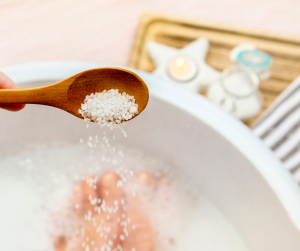
Anyone who knows me knows I take a bath almost every night. Originally, it was to help my sleep. Now my bathtub ritual is all about experiencing a quiet, relaxing, no tech mindfulness that floats me into a calm state. It is a time that is mine and that I cherish each night.

At the core, humans are water-based creatures. We are made up of 60 percent water. Our blood alone consists of 90 percent water. There has been much research on the health benefits of swimming, with many results noting big benefits to not only our physical health but also our emotional and mental health.
Water practices have been around for millennia, with therapeutic water practices ingrained in many ancient cultures. The Romans frequented public baths and often used spring water baths to treat illnesses. The Greeks embraced water therapy called thalassotherapy, which utilizes seawater as a healing medium through swimming, bathing, and applying sea-based products on the body. The Egyptians often integrated flowers and essential oils in baths for relaxation, and the Japanese were noted for their therapeutic use of hot springs.
Swimming as a practice appears as early as 2500 B.C.E. in ancient Egypt. Swimming was also part of military training in ancient Greece and Rome. Japan made swimming compulsory teaching in schools during the 17th century, and children of the Pacific nations learned to swim by the time they were toddlers. Swimming as a sport reached Europe in the 19th century, paving the way for the first swimming organization formed in London in 1837. In 1888, the sport of swimming was formally recognized in the United States by the Amateur Athletic Union.
Since then, swimming has become one of the most popular activities in the United States. The sport continues to be lauded for its overwhelmingly positive effects on cardiovascular health and muscular fitness. It has also been shown to balance blood sugar levels and lower blood pressure. A study published in Menopause, The Journal of the Menopause Society, noted that a committed swimming practice can be effective as both a treatment and a preventative measure for hypertension and other vascular diseases in postmenopausal women.

Swimming is a low-impact sport, which makes it favored across many age groups and ability levels. Swimming can suit a beginner, an Olympic athlete, and everyone in between, including those of us in midlife and beyond. The buoyancy the water provides helps take the weight off of achy joints, while at the same time providing a natural resistance that builds muscle. An added bonus of that buoyancy is that it takes weight off our feet which can help relieve inflammation and increase blood flow without the pressure experienced when walking and running.
Because swimming requires us to unplug (that’s right, no phones in the water), it can have an added meditative effect as we glide undistracted through the water. The ritual of swimming lap after lap gives our brains time to settle down and an opportunity for our stress levels to lower. The rhythm of moving from one swim stroke to the next combined with thoughtful breathing creates a meditative quality that can release endorphins in the brain associated with calm and well-being.
Swimming invites the swimmer to be present and aware of each stroke and each breath. Breathing is as important to swimming as mastering the strokes and kicks. It is the fuel that helps propel the movement. The proper exchange of oxygen moderates the heart rate and raises stamina. There is a rhythm and synergy that occurs as the swimmer unites their breath with each stroke and kick, setting their own pace. Swimmers have said that when their breathing is in line with their movement the practice feels effortless, almost idyllic.
Consider spicing up your worn-out workout routine or starting a new movement practice by diving in and giving swimming a go. Many gyms and activity centers offer swim classes or the use of their pool for an affordable fee. And if you need support to take that plunge, I offer Concierge Small Group Wellness programs for women in perimenopause and menopause, where we encourage each other to try new things and thrive during midlife.



